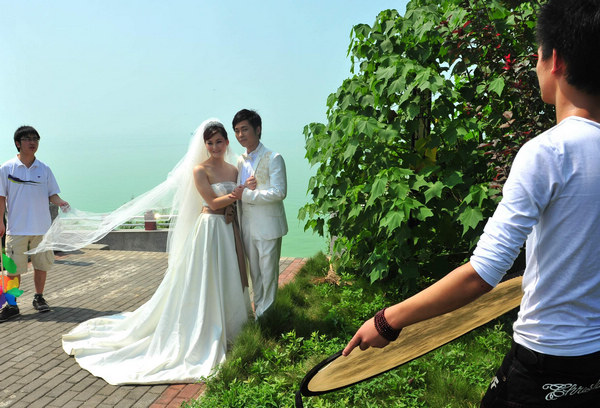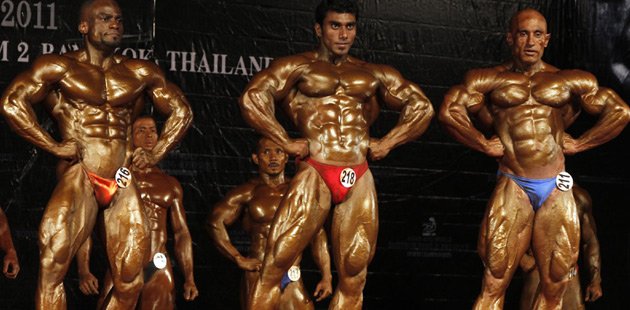|
|||||||||||
 |
|
A newlywed couple in Hefei, Anhui province, take their wedding pictures before the National Day holiday. [Xu Zhenhua / For China Daily] |
Drab clothes have given way to ruffles and sequins, feathers and lace, for today's Chinese brides. Chen Yingying from China Features reports.
For just 200 yuan ($32), brides-to-be can pick up their dream wedding gowns at Wedding Dress Mall in the western Beijing neighborhood of Wukesong. This spacious, bustling mall houses 80 stores stacked with inexpensive gowns that sparkle under the bright lights.
Young women wander in and out of these shops, tailed by their husbands-to-be, mothers or girlfriends, trying on the dresses in fan-shaped booths or behind swaths of fabric held up by the shopkeepers.
They bargain hard for a good deal and, once satisfied, the dress, complete with ruffles, sequins, feathers, or all three, is tucked into a giant bag to be taken home.
"I would like to wear a white fluffy dress that will make me feel like an elegant princess, just like Kate Middleton, the wife of Prince William," says Linda Wang, a 27-year-old bride-to-be from Beijing's Tongzhou district, thrilled with her relatively expensive 500 yuan dress.
Wang says the wedding dresses here look just like the big name-brand ones, but are much more affordable. Buying a dress here is often cheaper than renting one, as rentals can go up to more than 1,000 yuan.
"In other wedding dress shops in Xidan or SOHO in Beijing, the price of a wedding dress ranges from 5,000 yuan to more than 20,000 yuan," she says.
Wang does not care much about the texture or quality of the dress. "I will only wear it once, so it really isn't worth too much money."
Western-style wedding dresses have become obligatory at Chinese weddings today, although some brides still prefer a cheongsam or other traditional Chinese dresses to appear distinctive.
In the Ming (1368-1644) and Qing (1644-1911) dynasties, a bride typically donned a phoenix coronet and an embroidered vest, inspired by the royal costumes of the Ming Dynasty.
The 1911 Revolution ended feudalism and dynastic traditions in China, and led to the formation of the Republic of China. The cheongsam, or qipao, became China's national costume for women at this time.
The cheongsam evolved from Manchu fashions, which were originally made loose to hide a woman's figure. During the 1920s, tailored and fitted cheongsams became popular with Shanghai's upper-class women.
The 1911 Revolution also dealt a death blow to traditional wedding ceremonies. A new style of ceremony known as a "civilized wedding" emerged and was popularized after the Revolution.
Traditional Chinese customs were simplified and the ceremony was significantly shortened. The groom donned a black robe with a mandarin jacket over it, while the bride dressed in a cheongsam and bridal veil, and carried a bouquet of flowers.
Traditionally, a bride wore red, a color symbolizing joy and happiness, on her wedding day. White was reserved for a death or funerals and was not considered auspicious for weddings.
Western-style dresses first came into fashion in China with Chiang Kai-shek and Song Meiling's wedding in December, 1927. Song wore a conventional Western-style floor-length gown of white satin and lace, and carried a massive flower bouquet.
During the "cultural revolution" (1966-1976), Western-style wedding gowns were seen as signs of a bourgeois lifestyle and banned. Weddings during this period had to be as austere as possible, and most couples wore ordinary clothes, with some even dressed as Red Guards, and carried Chairman Mao Zedong's quotations in lieu of a bouquet.
Western-style wedding gowns made a comeback in the 1980s with the start of the reform and opening-up policy. Today, most brides wear these gowns before changing into a cheongsam for the toast.
Although the ceremonies are tailored to local customs, a Western-style dress has become a must-have for Chinese brides - even in remote, rural areas.
Zhang Chengjun, a 24-year-old migrant worker from Lixian county in Northwest China's Gansu province, says many brides in his village would like to dress in white, but since the color is still considered taboo by older folks, many opt for a red gown instead.
"My wife personally prefers the white one, because it is popular and also looks pure," Zhang says.
However, brides in more open-minded villages can wear what they like. Yang Lei, a 26-year-old security guard from a small village in Handan, Hebei province, says his wife wore a white gown that she thought "would make her look like a princess".
Yu Fan, who runs a wedding dress shop in downtown Beijing, says: "Today, almost every girl dreams of wearing a Western-style wedding dress." But she also points out that these gowns are heavily altered to suit the stature and skin tone of Chinese women. Gowns with clusters of sequins and embroidered peonies or phoenix are more popular than unadorned, simple ones, Yu says.
Wedding dress workshops in southern cities like Hangzhou, Suzhou and Shenzhen supply shops like Yu's in Beijing, but some brides prefer to go straight to the dressmakers. Huqiu Wedding Dress Street in Suzhou, Jiangsu province, is famous for its inexpensive wedding dresses and attracts brides from far and wide.
Besides designing their own dresses, tailors can also copy designs from abroad. A tailor in Huqiu claims to have made the first copy of Kate Middleton's dress just 31 hours after the royal wedding.
But for Yang Se, the founder and CEO of idoido.com.cn, a popular website offering wedding service information, a wedding dress is more than just a thing of beauty.
"It represents the solemnity of marriage. People should treat it with respect," she says.
Yang, 31, has organized hundreds of wedding ceremonies and is currently preparing for her own wedding. She plans to wear a Vera Wang gown for the ceremony which will be held in Los Angeles. "I have been looking forward to my wedding since childhood. I would become excited whenever I watched a wedding in films or on TV," she says, adding it was the US TV show Friends that inspired her to get married in a Western-style gown.
Like Yang, Linda Wang also wants a Western wedding ceremony. She went to Wukesong market six times before buying her 500 yuan wedding dress.
"My wedding should be romantic, held on the lawn and have many garlands and bouquets - just like I have seen in the movies," Wang says.
Hot Topics
Libya conflict, Gaddafi, Oil spill, Palace Museum scandal, Inflation, Japan's new PM, Trapped miners, Mooncake tax, Weekly photos, Hurricane Irene
Editor's Picks

|

|

|

|

|

|







